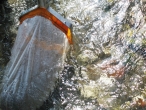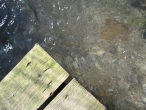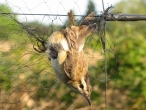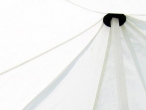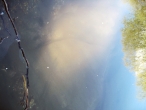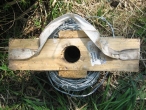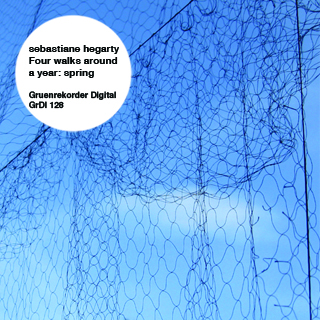
Four walks around a year: spring | Sebastiane Hegarty
The first instalment of the winnall moors soundwalks
GrDl 128 | Gruen Digital > [order]
MP3 & FLAC
The spring walk is the first of four soundwalks through a year in Winnall Moors Reserve, Winchester, England. During 2013, the full suite of walks will be slow released by Gruenrekorder Digital, each perambulation reflecting the season of composition.
Re-composed from recordings made through March, April, May and June, the spring walk begins at dawn with the first isolated notes of birdsong and my own frosted footsteps upon a boardwalk over the reed beds. The birdsong builds in volume and complexity as several dawns combine to reveal a polyphonic chorus, surrounding the listener in territories of song. The company of my own footsteps lead the listener into an emerging landscape, simultaneously reminding them that another was present here and that this dawn is now passed. When composing the walk I did not feel it important that the coordinates of the soundwalk be arranged in strict correspondence to the fixed geography of the moors: that is, I did not attempt to map precisely and chronologically a fixed circumnavigate movement through the landscape. I preferred to let the sounds organise their own path, although by chance the location of the dawn chorus, with which the walk opens, corresponds almost exactly to location of the creaking pagoda, with which it concludes. This suggestion of circular transit is echoed in the flight path of a bank of swans that are heard arriving and evaporating, before returning only once more to disappear. At the finale of the walk a bouquet of warblers, having returned here from Africa, throw their songs of DNA into the air, whilst a work party sinks a wooden post into the ground and a mobile phone adds a digital phrase to this chorus of territorial voices. The vibrations of human toil are telegraphed down a wire fence, surrounding the moors in one more acoustic circumference as the pagoda adagio closes in.
sound descriptors: a list of sounds as they appear on the spring walk
Crackling hesitant steps, a pause, a bird singing, another song, and another, brittle steps on the wire covering a boardwalk, a dawn chorus, geese fly past, another dawn, a green woodpecker, dismantling the ringing nets, a bird hanging in a cotton bag, ringing, a call of distress, release, feathers against cotton, dismantling the ringing nets, a stream, a kick sample, rolling the river bed, trickle of water, foot steps on gravel, river hatch, a girl screams, preening swans, pond dipping, nets dripping, pagoda bending, pond effervescing, a herd of tadpoles, a cuckoo, post hole pincers, shovel of earth, sinking post, swans circling, sedge warbling, swans returning, reed warbling, a creaking pagoda adagio.
Background
The Winnall Moors soundwalk project was made in collaboration with Hampshire Wildlife Trust (HWT). The project began in the winter of 2010, with the aim of creating a soundwalk based on recordings made in the Winnall Moors conservation reserve over the period of one year. Extending the recording process over this timescale, allowed the discrete temporal patterns of the landscape to become apparent. The inclusive nature of the sounds collected, reflect both the complicated topography of the reserve, which is at once a shared public space, a historic and natural landscape and an area of encircled wilderness.
As the project progressed, it became apparent that composing one soundwalk for the whole year would be restrictive. It seemed more appropriate for there to be four walks, responding to individual acoustic character of the years celestial quarters: winter, spring, summer, autumn. The temporality of the sonic environment is reflected not only in the migratory, seasonal wildlife sounds, but also in the calendars of local, human and conservation activity.
The duration of each soundwalk is set at twenty-five minutes, which roughly corresponds to the time it takes to walk a full circuit of the moors reserve. For the purposes of the HWT, the soundwalks provide a form of poetic audio guide; a sort of headphone transit, that may allow the previous and present sonic landscape to intertwine.
I would like to extend my sincere thanks to all the employees, wardens, scientist and volunteers at the Trust and in particular, Martin De Retuerto, Rachel Remnant and David Eades for their help, inspiration and support.
1 Track (25′01″)
Field Recording Series by Gruenrekorder
Gruenrekorder / Germany / 2013 / GrDl 128 / LC 09488
Hal Harmon | Musique Machine
Gruenrekorder imprint presents Four Walks Around a Year: Spring by british artist, writer, and lecturer Sebastiane Hegarty.
Spring is the first entry in the Four Walks Around the Year series. As the title implies, these recordings are represent four soundwalks at the Winnall Moors Reserve in Winchester, England. Each recording will coincide with one of the four seasons, this one being Spring. Over the span of 25 minutes we’re greeted by the sounds of: birds chirping in chorus, geese, human voices, rolling river water, footsteps, creaking wood planks, a metal shovel digging, and a myriad of other natural recordings. Incidentally, 25 minutes is approximately the amount of time it takes to walk a full circuit of the reserve.
As with all Gruenrekorder releases all the sounds are expertly captured and really transports the listener to a majestic environment teeming with wildlife and human spectators. There’s a real emphasis on the variety of birds found in the reserve, though that’s not necessarily intentional. As Hegarty mentions in the liner notes, the sounds present on the recording organised their own path. It will be interesting to hear the seasonal change on the subsequent 3 releases that follows Spring.
Four Walks Around a Year: Spring is your perfect audio tour around grounds of a natural reserve. A picture perfect slice of life captured in stunning clarity.
link
Richard Allen | a closer listen
How well do you know the soundscape of your own neighborhood? Are you in tune with the seasonal changes, the cries of different birds, the direction in which they migrate, the flow of local river banks and drainage systems? Do you know when the neighbors come home from work and when their children leave for school? Do you know their names, or the names of the trees in your yard, or the thickets that grow behind them? What creatures live on your property, and what sort of sounds do they make? Where do they go in the winter ~ do they migrate, burrow, or die?
These are the sort of questions that interest Sebastiane Hegarty, whose series Four Walks Around a Year has just drawn to a close. His 25-minute walks around the Winnall Moors Preserve have now been captured for all generations, one recording for each season, each recording combining the sounds of multiple forays. Gruenrekorder’s website provides an elaborate description of the walks, along with complete lists of identifiable sounds: much more than one might guess without prompt. When listening to the project in full, one experiences an entire year in a hundred minutes.
05Here’s the sound of footsteps on hardened ground, and birds singing their joy at the returning sunlight. It’s spring in the reserve, and there’s plenty of life in the moors. The African warblers have just returned; the workers are at their posts; the water is flowing freely in the river. Human equipment can be heard in the distance, never far from nature. Spring is a time to check the reserve and to see what has survived. Has the winter been harsh? Have all of the residents made it through? Has the grass received enough moisture to sprout? The people sound as happy as the birds. The layers are being shed, the windows are being opened, the populace is venturing outside. Children are gathering, crying, playing. ”Don’t drop it on its head!” warns an amused gentleman; hopefully the child has not captured a swan.
06Will summer be different? Indeed. Again we begin with footsteps and birds, but the soundscape has subtly changed. Hegarty refers to the turnover as “calendars of sounds”. Summer adds grasshoppers and wasps, ice cream trucks and active construction. A brief downpour affects the river and the leaves. As the initial burst ends suddenly, one remembers that this is not a single walk, but a patchwork; sounds are moved around in order to highlight their properties. Hegarty also writes about the absence of sound: “the ghosts of sounds no longer here.” It’s harder to hear what’s absent than what’s present, but the release trains us to concentrate and remember. The different timbres of precipitation make this the most immediately compelling of the walks, but “Wednesday evening bell practice” contributes an especially lovely angle. No offense to humans, but the lessening of voices in the summer walk is a draw as well.
02To autumn now: crunch, bird, we’re off again, a similar introduction launching into the reverse of spring. Now the birds are saying their goodbyes, morose perhaps at the thought of so much travel. Or perhaps this is simply human projection. As Hegarty notes, the water sounds different: thinner, colder, in the author’s words, “sharp and slightly angular.” Shorthand radio conversations are interspersed with personal exchanges; the birds seem to retreat, having more important things on their minds. ”A very good day today”, a woman declares. The traps have been set, more to help the local animals than to harm them, as conservation is frequently ironic. The natural soundscape is clearly quieter than the preceding installments, as the aforementioned ghosts have become obvious.
05And finally to winter. The final installment begins with wintry tales, rescued from the archives. ”Before this war we used to go skating”, reminisces an older man. And then it’s frost, ice, snow, and rain. Now that one has been trained, one notices the subtraction of flocks. Individual birds call to one another, either hardy or left behind; but the sonic field is wide open. When they are suddenly pulled from the recording in the fourth minute, one can’t help but wonder what has happened. Chalk, CO2 and crystallized air are amplified in the resulting crevasses. By the end, Hegarty himself grows melancholy, writing, “I have become a ghost listening to myself not now there.” The winter walk is a lonely walk, but it is not empty; to enjoy it, one needs the mind of Wallace Stevens (“The Snow Man”):
For the listener, who listens in the snow,
And, nothing himself, beholds
Nothing that is not there and the nothing that is.
link
Jay-Dea Lopez | The Field Reporter
It is often said that a place cannot be known until each of its seasons have been observed. The transitions in temperature and light, the migration of wildlife and the changes in human activities each signal the way in which a particular site is in a permanent state of flux. In the past landscape painters have depicted visual changes characterised by each season; in classical music such as Vivaldi’s “Four Seasons” sought to interpret the temperament of each season. So it would seem field recording is a perfect medium to follow in this tradition, capturing local sounds as they ebb and flow with the seasons. This is precisely the aim of Sebastiane Hegarty’s latest work “Four walks around a year: spring” released through Gruenrekorder.
The Winnall Moors Nature Reserve is the object of study in Hegarty’s four walks series. “Spring” is the first in a series of soundscapes interpreting this reserve which lies close to the city of Winchester in England. Hegarty’s plan is to represent each season through a 25-minute soundscape, the timing corresponding with approximately how long it takes to walk the full circuit of the reserve. Unlike other soundscapes specific to a particular area Hegarty’s “Four walks around a year” is not interested in faithfully detailing the exact location of each sound recorded, rather he attempts to mix the recordings in such a way that the underlying tone or ambience of the site is reproduced for the listener. If the Winnall Moors Nature Reserve is as filled with the tranquil timbre that is presented in this soundscape then Hegarty has fulfilled his objective.
“Spring” merges the sounds of animal life with those of people either working in the park or enjoying the park recreationally. The piece opens with a recording of a dawn chorus and later progresses to the sound of a bird caught in a net. The contrast between the two is quite poignant. Interspersed between the sounds of birdlife we overhear snippets of conversation between workmen as they maintain the infrastructure of the park. Listening to them we are reminded of how constructed this natural place actually is. For a brief moment we are also privy to conversations between adults and children as they engage with the natural elements of the park. By including these vignettes Hegarty captures what feels like a moment of hope for the future.
Just as the reserve can partly be seen as a construct so too is Hegarty’s soundscape. We are especially reminded of this as we overhear Hegarty himself in the recordings. The sounds created by Hegarty as he walks upon a frosted boardwalk remind the listener of his role in sourcing the material that is eventually used in the soundscape; there is something physical or tangible about his presence in these crisp crunching steps that position us there in his boots. As we listen to him we become his companion throughout the walk.
“Four walks around a year: spring” is a good beginning to what promises to be an absorbing series of work by Hegarty. As the sounds endemic to the ensuing seasons are recorded it will be interesting to compare not only the differences between what can be heard but also the way in which Hegarty presents them. We look forward to hearing more from Hegarty in summer.
